 Be Inspired Blog - Arizona
Be Inspired Blog - Arizona

Tillandsia Basics: How to Revive Dehydrated Air Plants
Tillandsia, or air plants, are incredibly popular and versatile houseplants for home decorating because they don’t require soil, but it’s important to know how to revive an air plant in case it’s getting a bit dried out. In nature, air plants can often be found growing on trees in humid rainforests. Since they aren’t in a pot full of soil, how to water them will be a little different, and it takes some practice to nail down a consistent, effective watering routine.
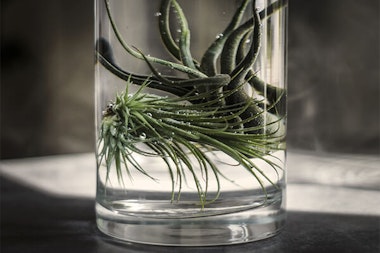
Watering Air Plants
The best way to water tillandsia is to soak the bottom of the plant in a cup of water for about 5–10 minutes, every 7–10 days. Tap water that’s been left sitting out for a day will work well, but rainwater or pond water is ideal if you can attain it. While trace chemicals used to keep tap water clean, like chlorine, evaporate out of the water when exposed to air for prolonged periods of time, naturally-sourced water doesn’t contain these chemicals. After soaking, shake any excess droplets off the plant and then let it sit to dry out, preferably upside down on a paper towel-lined plate. This is so the water drains from the base and doesn’t collect between the leaves, which can lead to rot. Typically, it shouldn’t stay moist any longer than three hours after soaking, or else you probably soaked it a bit too long. Every few months, you can try adding a little spritz of orchid fertilizer to help boost growth.
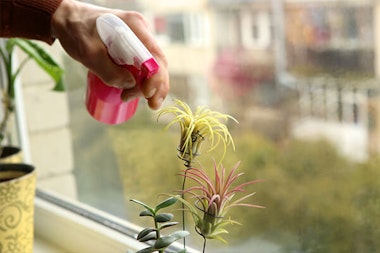
Once your plant is dry, place it back where you display it. Humidity is also important for keeping tillandsia happy, so if the air is a bit dry in your home, especially in winter, and you don’t have a humidifier, it’s a good idea to use a mister and lightly spray the leaves once per week. Again, make sure you don’t overdo it! Soggy plants can lead to rot, which is a lot harder to treat than dehydration.
If your plant is in a glass terrarium, or if it’s been mounted to driftwood or another fixture with glue and you’re unable to remove and soak it, just mist it a little more frequently. You’ll find glass terrariums have their own microclimate that’s a bit more warm and humid than outside, so your plant should be pretty comfortable in there.
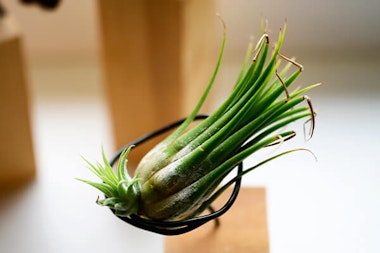
Is My Air Plant Dead?
If the leaves of your tillandsia begin to dry out and have a more pronounced convex shape, this doesn’t necessarily mean it’s dead. It might just be a little dried out, in which case, you can perk up an under-watered air plant by increasing the frequency of watering and misting. You can even try bringing the plant into your bathroom and placing it on the counter while you take a shower, so all the steam from the hot water will help rehydrate the leaves.
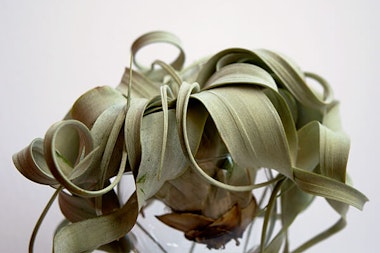
It’s also important to make sure the plant is receiving enough light. Generally, bright indirect light is best, so placing your tillandsia near a South or East-facing window will provide it with the right amount of sun. The higher the humidity in your home, the more sunlight tillandsia can handle, so if your home is a bit on the dry side, don’t put your plant right on the windowsill, or it might end up getting fried. Be careful with plants in glass terrariums, too, because the glass can act as a magnifying glass if it’s in a bright sunbeam, and could end up scorching your plant.
Now, eventually, your tillandsia will reach the end of its life cycle and will die. This typically occurs after it flowers, which only happens once in its cycle. However, before it bites the dust, it will produce a few “pups” that can be plucked off and grown into full new plants! Just continue with your regular watering routine, and wait for the pups to get at least ⅓ the size of the mother plant before separating them. They’re still soaking in nutrients from the mother plant while they’re attached, so you may as well wait it out a bit so they can get as much nutrition as they can.
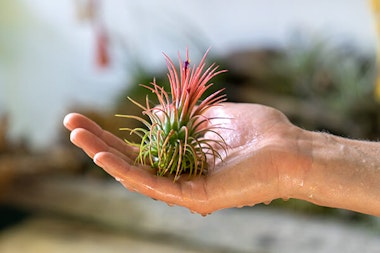
Signs of an Overwatered Air Plant
Unfortunately, an overwatered air plant is a lot harder to rescue than a dry plant, so if you spot any signs of rotting, stop watering immediately until it clears up. If the center leaves are falling out, or the base of the plant begins to turn black or brown, this is a sign that it’s beginning to rot from too much water. Remove any damaged or diseased parts with sanitized shears, put the plant in a sunny spot in the room, and hope for the best! If it looks like it’s making a recovery, resume watering after two weeks, and be sure to shake off all the excess droplets thoroughly!
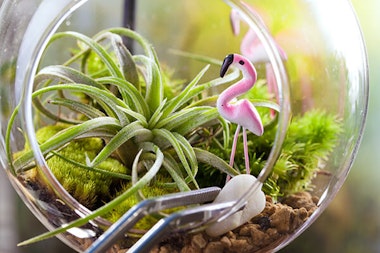
Want to try growing your own tillandsia plants at home? There are so many creative ways to display them and so many interesting varieties to add color and texture to your bookshelves, desks, windowsills, or anywhere else in your home that could use a little extra greenery. Visit your local SummerWinds Nursery to see our full collection, and maybe pick up a cool glass terrarium or hanging planter while you’re at it!

